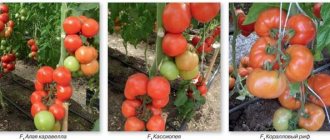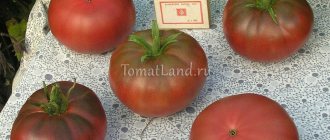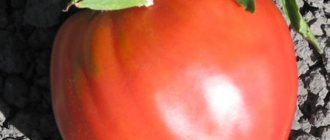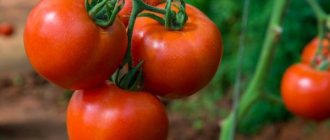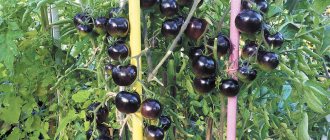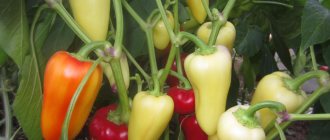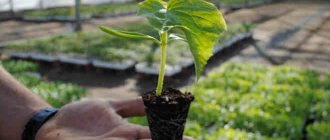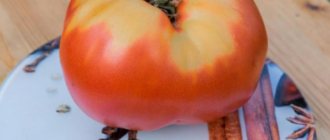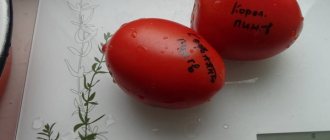Tomato Miracle bunch f1 is a representative of cherry tomatoes, which are valued not only for their taste, but also for their decorative qualities. They ripen quickly and produce a good harvest, especially considering the tiny size of the fruits.
| Height | Landing location | Ripening time | Fruit color | Fruit size | Origin | Fruit shape |
| Tall | Open ground | Early ripening | Reds | Small | Hybrid | Round |
Description and characteristics of the variety
Cherry tomato Miracle bunch f1 is a hybrid bred relatively recently.
It was included in the State Register in 2012. It is recommended to be grown in open ground; it tolerates weather vagaries, cold snaps and drought well. But when planted in a greenhouse, it also develops well. Characteristics of tomato bushes: they are indeterminate and do not self-grow; they require formation. The height reaches 1.7-1.9 m. There are few leaves. The inflorescences are complex, they develop many ovaries that form large clusters of tomatoes. Description of the fruits: ripen 90-95 days after the seeds hatch. Tomatoes weigh 10-20 g, are round, bright red. The pulp is juicy, sweet, and usually has no sourness. You can eat tomatoes fresh, can them individually or on bunches, decorate and include in dishes. It is necessary to harvest frequently, as overripe tomatoes fall off the trusses.
Why is there no ovary
- Poor pollination. Greenhouse tomatoes especially suffer from poor pollination. For prevention, you should ventilate the plant more often, shake the bushes, and sow honey-bearing herbs nearby to attract insects. You can spray with sweet water.
- High humidity. With high humidity, the pollen on the flowers begins to stick together and pollination does not occur. To reduce humidity, use a drip irrigation system, control the frequency of moisture and mulch the soil.
- Violation of the frequency of fertilizing. When growing tomatoes, the rule is to feed, but not to overfeed. Excess nitrogen and lack of mineral supplements have a particularly negative effect on flowering.
Landing
Plant seeds for seedlings in March. When planted in the ground, the age of the bushes should be 55-65 days. Overgrown seedlings take root worse, and the plants are not as productive.
Before sowing, prepare the seeds and soil:
- Mix 1 part of peat, humus and garden soil, add 1 or 0.5 parts of sand, as well as 1-2 cups of wood ash and 1-2 tablespoons of superphosphate per bucket of the mixture;
- The finished substrate is disinfected in one of the following ways: frozen outside or in a freezer, calcined in an oven at +110 degrees, poured with boiling water or a hot solution of potassium permanganate or copper sulfate;
- Treat containers for planting with a disinfectant composition;
- Hybrid seeds do not require treatment, but just in case, you can disinfect them with potassium permanganate and soak them in a stimulant solution.
In boxes with soil, grooves are made 1-2 cm deep, seeds are sown, and covered with soil. Water by spraying from a spray bottle. Then the glass-covered boxes are placed in a warm, well-lit place at +25 degrees. Sprouts appear after 5 days or a little later. When more than half of the seeds have sprouted, reduce the temperature and remove the film.
To prevent the bushes from becoming thin and stretched, they are kept at a temperature of +16 for the first three days. Then it is raised to +18-22.
You can feed the seedlings 1 or 2 times. In the phase of 2-3 leaves, seedlings dive. 3-4 bushes per 1 sq.m. are placed in a permanent place.
Diseases and pests
| Late blight Ways to fight:
| |
| Necrosis Ways to fight:
| |
| Macrosporiasis Ways to fight:
|
Growing and care
The tomato requires formation during the growing process. It must be kept in one stem and regularly pruned. When the top reaches the edge of the trellis, it is pinched. The stem is tied to a support.
Water weekly or twice a week, depending on the weather. Watering should be plentiful, but if water stagnates in the soil, it should be reduced. In hot weather, on the contrary, they increase it. Water in the morning or evening.
It is necessary to slightly heat the water, otherwise the tomatoes may lose their ovaries.
Feed 3-4 times:
- A week after rooting, add a solution of mullein 1:10;
- During flowering, water with a solution of superphosphate with potassium sulfate and the addition of mullein;
- For ripening, superphosphate is added or sprayed with a solution of boric acid.
Reviews from gardeners
Fan
I’m simply obsessed with tomatoes, not to say that I love eating them very much, but it’s interesting to grow them (my family is the opposite). At first I even kept records by variety based on yield, but now I’m lazy. But I tested 200 varieties. The main conclusion is that you need to choose tomatoes specifically for yourself; some varieties that grow very well among my neighbors grow sluggishly and vice versa.
Source: forum.tvoysad.ru
Vega
The sweetest as always are Sungold (Suttons) and Sweet million (Suttons), they are also the most productive. In third place are Black cherry, which the children liked the most, but I found it much tastier than Brown berry, which has a much more sour taste and is not as rich. In addition, Black cherry is larger. In terms of yield, these two were the same.
Source: forum.tvoysad.ru
"Sweet bunch of chocolate"
The same agricultural company launched on the market, in addition to the “Sweet Bunch” variety, also the “Sweet Bunch Chocolate” tomato. The variety is not included in the register. Served early for open and closed ground.
Description of the variety
The variety is indeterminate. Its height is in the range of 150-170 cm. The plant is well leafy with an increased ability to form stepsons, therefore it requires constant formation until the end of the growing season.
Tomato fruits weigh about 30 g on average, leveled, smooth, round. The skin color is dark cherry with a brown tint. When cut, the tomato is a rich dark red color. It has 4-5 seed chambers with small seeds. Very juicy.
The skin is dense, but when removed, the tomato separates from the stalk and the skin tears. This property often upsets vegetable growers, and many refuse to grow the variety.
The tomato is intended for consumption as salad products and for canning whole fruits. The tomato tastes good. The sweetness is detected from the first notes, and there is also a pleasant aftertaste.
Tomatoes are also good for canning, they do not crack, keep their shape, are moderately dense, but the skin is not eaten.
Disease resistance
There is no information from the author on the variety’s resistance to diseases. But those vegetable growers who have already grown chocolate tomatoes respond favorably and claim that the tomato does not require more attention than other varieties.
However, looking closely at the photos attached to the description of the variety, you can see that the foliage is abundantly covered with copper-containing preparations, and this suggests that the variety can show resistance with regular preventive treatments with fungicidal preparations.
Whatever the reviews, from the beginning of formation until the end of the growing season, plants must be processed. Alternate antifungal agents, this will not allow microorganisms to form an addiction, and the effectiveness of treatments will increase significantly.
Description of the American tomato Cherokee Green golden and growing in seedlings
The Cherokee Green golden tomato was bred by US breeders in 1997. This is a rather rare variety for Russia, colored brown, green and gold. The Cherokee Gold tomato does not crack from mechanical stress, despite the fact that the tomato has a fairly thin skin.
It can be grown in open ground only in the southern regions of Russia, and in the open spaces of the middle zone and in the northern regions of the country, greenhouses and hotbeds have to be used. The tomato variety described is not intended for transportation or long-term storage, so it is consumed fresh, salads and tomato juice of unusual colors are made from it.
Technical data of the variety
The characteristics and description of the plant are as follows:
- Cherokee Green Gold belongs to the group of tomatoes with medium ripening periods. The vegetative period of development lasts up to 130 days - from seedlings to the first harvest.
- The height of the plant bushes ranges from 160 to 180 cm. A bush is formed from several stems, on which many leaves are formed, colored green and evenly spaced along the tomato trunk.
- Cherokee Green has practically no branches in width. All the plant's energy goes into growing the bush. From 4 to 5 clusters develop on the stem, which produce 5-6 fruits.
- Tomatoes of the described variety have the shape of a ball flattened at the top and bottom. The weight of the fruit ranges from 0.3 to 0.5 kg. The ripe berry is colored brown and yellow on the outside, and green (emerald) on the inside, with a small number of seeds. The surface of the fruit is shiny, with clearly defined ribs. The pulp is aromatic and contains a lot of juice.
- The harvest can be harvested throughout the summer. The first berries ripen approximately 117-127 days after the seedlings appear, and then the plant bears fruit throughout the summer.
Reviews from farmers growing this variety show that tomato yield ranges from 3 to 7 kg of berries per bush. Gardeners note that when sown in open areas, the first fruits can reach a maximum weight of 400-500 g, and the weight of subsequent berries is reduced to 0.15-0.3 kg.
When growing the described tomato hybrid in a greenhouse, gardeners receive berries of the same weight, the average weight of which ranges from 250 to 300 g. Farmers consider the disadvantage of the variety to be the need to harvest stepsons and install supports under the branches of plants.
Growing seedlings in your own backyard
To obtain a high yield, the correct biotechnology for planting and growing Cherokee Green must be used.
Seeds are disinfected in a solution of potassium permanganate. They are then soaked in water to swell. Floated specimens are thrown away. Planting material is planted in boxes or separate cups filled with soil for tomatoes. The container with seeds is installed in a warm, well-ventilated area.
When the first shoots appear after 7 days, they are watered with warm water and fed with manure or peat.
Before planting seedlings in the soil, loosen the ground, apply complex mineral fertilizer (no more than 1 tbsp) to each bush. The format for planting bushes is 0.5 X 0.5 m, each bush is formed from 2-3 stems. The lower leaves need to be torn off, as they immediately begin to dry out.
Self-care for tomatoes
When flowering, plants are fed with superphosphate and potassium sulfate. During fruit formation, the bushes are fed with magnesium sulfate, pouring the solution under the root.
Cherokee is watered only during severe drought. To do this, use water at room temperature. It is necessary to ensure that the liquid does not wash out the root system of the plants, otherwise up to 30% of the harvest will be lost.
Loosening is carried out 1-2 times a week. You can mulch the soil so that all useful microelements and moisture are retained in the soil. The gardener must weed the beds once every 2 weeks.
Although Cherokee Green is immune to all diseases, it is recommended to carry out preventive spraying of the bushes with medicinal preparations. If the farmer has treated the seeds with pesticides, then there will be no need to use any additional products. This measure will also save the plants from damage by the Colorado potato beetle.
When aphids, mites, and caterpillars of various insects appear on tomato leaves, they are destroyed with toxic chemicals.
Tomato diseases and their treatment
Septoria. Viral infection of tomatoes. Another name is white spotting. Causes leaves to dry out. Has a strong impact on overall yield. The leaves at the bottom of the bush are the first to be affected. Spread is favored by high humidity and high temperatures. The main infection of plants occurs in August - early September.
Treating seeds against this viral infection will not help. The disease is not spread by seeds. It is necessary to remove the affected leaves. Treating the soil hole and plants with preparations containing copper will help. For example, "Horus" or "Zineb".
Choosing the Red Icicle variety for planting on a farm or in your own plot is a guarantee of obtaining well-stored tomatoes, ideal for any purpose, from salads, processing for juice, to pickling and fresh sale.
In the table below you will find links to tomato varieties that ripen at different times:
| Super early | Mid-season | Mid-early |
| Leopold | Nikola | Supermodel |
| Shchelkovsky early | Demidov | Budenovka |
| President 2 | Persimmon | Major F1 |
| Lyana Pink | Honey-sugar | Cardinal |
| Locomotive | Pudovik | Bear Paw |
| Sanka | Rosemary pound | King Penguin |
| Pickling miracle | Beauty King | emerald apple |
Recommendations and opinions of vegetable growers
Of course, almost any indeterminate variety, and even more so a new hybrid form of tomatoes, can be turned into a similar tomato tree if desired. If you have a year-round heated greenhouse structure, as well as using hydroponics and carrying out a certain shaping of the plant, the result will be approximately the same as in the delightful photographs of the miracle tree.
“I used to grow different varieties of tomatoes at my summer cottage. Last year, on the advice of a friend, I planted Ivanovich tomatoes. I plant all plants using seedling method. After planting in the ground, we eagerly awaited the first harvest. The yield exceeded all our expectations! The taste of the fruit is excellent."
“A neighbor at the dacha advised me to plant a tomato Ivanovich. I tried it. Maintenance is simple and standard. Tomatoes tolerated temperature changes well. The yield is good."
Reviews from gardeners growing the Rally hybrid indicate the high yield of the crop, excellent taste of large fruits, and the ability to be transported over long distances due to its dense skin.
“I’ve been growing tomatoes in my summer cottage for many years. I am fond of tall varieties, since the conditions are specially created for this
The Rally variety attracted attention (except for the ability to form a tall bush) due to its large fruits. Juicy and soft fruits, with thick skin, very aromatic, pleasant to pick from the bush
They are not suitable for whole canning, but they can be used for salad or other dishes.”
“On the recommendation of neighbors, I purchased the seeds of the Rally hybrid. The variety pleasantly surprised me with the ability to grow tomatoes in a greenhouse, high yield, and ease of care. A plant has formed, the appearance and characteristics of which are the same as in the packaging photo. The fruits are very large, juicy, and pleasant to the taste.”
Bush care
Like any indeterminate variety, “Black Bunch” requires proper formation. Stepchildren begin a week after landing for permanent residence. The bush must be formed strictly into one stem, otherwise a large amount of non-marketable small items will grow. The stepsons are broken out when they reach a length of 5 cm, leaving 3 cm of hemp to prevent relapse.
Other rules of agricultural technology:
- Attachment to a trellis, post or greenhouse frame. Performed as needed;
- Shallow watering with warm water every 3-5 days;
- Loosening with careful weeding. It is carried out in the interval between waterings;
- Feeding with NPK complexes according to the schedule once every two weeks.
History of variety selection
Tomato Grozdevoy F1 belongs to the first generation hybrid varieties, as indicated by the designation F1 in the name. This variety is an achievement of Russian breeders from; it was included in the State Register of the Russian Federation in 2010 and is recommended for cultivation under film shelters not only in the central, but also in the northern regions.
Cluster F1 belongs to the cluster tomatoes, which are characterized by the setting and ripening of fruits in the form of a cluster. They are more resistant to both diseases and climatic conditions.
This type also includes:
- French grape;
- Black grape;
- Siberian grozdevoy.
Advantages and disadvantages
Since its appearance on the market, the tomato has quickly won fans because it has many advantages:
- The hybrid is protected from many diseases.
- The crop does not stop forming fruits in the absence of light, infrequent watering, or sudden cold weather.
- With a small weight of tomatoes, the plant shows good yield.
- Tomatoes look impressive when canned and can decorate salads made from fresh vegetables.
- The harvest does not deteriorate due to uncomfortable transportation.
- Ripe fruits have significant shelf life.
- In areas with short summers, the tomato has time to fully ripen.
The hybrid also has disadvantages:
- seeds collected from their own tomatoes will not produce a yield similar to the mother plant;
- Without formation, bushes break, yield decreases.
Attention! Cherry fruits, when fully ripe, fall off the brush easily. The gardener should not delay the harvesting of tomatoes.
Features of agricultural technology
Tomato Miracle bunch F1 is grown without seedlings only by farmers from the southern regions. In other areas, preliminary preparation of seedlings is necessary. Agrotechnical recommendations for the hybrid:
- seeds are sown in early March;
- It is necessary to pick seedlings after the appearance of 2 leaves;
- the tomato is moved into the ground when the seedlings reach the age of 2 months;
- bush planting density – 3 pcs. per 1 m2;
- the plants are tied up and pinched in such a way that 2 long strong stems with bunches of tomatoes are formed;
- in the last days of summer, the top part of the crop is pinched;
- water the tomato every 3 to 4 days;
- The optimal number of feedings is 3.
Why is this tomato valued?
The Miracle Bunch hybrid is considered a new product, but it has already managed to “find” its admirers. Advantages:
- early ripening;
- pleasant taste, sweetness;
- tomatoes with beautiful red clusters are very decorative;
- disease resistance;
- high yield - up to 3-3.5 kg from one cherry bush;
- resistance to adverse weather conditions;
- the variety can be grown in beds in open ground and under film covers, in polycarbonate greenhouses;
- versatility of fruit use.
Not everyone knows the beneficial properties of miniature cherry tomatoes. Their fruits contain a large amount of dry matter, due to which they have high dietary value.
ON A NOTE! Cherry tomatoes are recommended to be consumed to lift your mood. These tiny tomatoes contain substances that are involved in the synthesis of the “happy” hormone serotonin.
The characteristics and description of the variety will be incomplete without indicating the disadvantages. The “disadvantages” are related to agricultural technology, since for all its unpretentiousness, an indeterminate hybrid requires certain care:
- formation of a stem (usually the Miracle bunch is led into one trunk);
- stepsoning;
- abundant, regular watering and fertilizing.
The “minus” is also that you won’t be able to take your own seeds from the fruit, since the tomato is a hybrid.
Beneficial features
Miracle bunch tomatoes are harvested at the stage of technical ripeness. Green fruits set aside for ripening will not have the characteristic taste. After the onset of biological ripeness, tomatoes fall off the branches, and an overripe crop is prone to cracking. Transportation is carried out by placing the tomatoes in plastic containers, carefully closing them with a lid.
The pulp of the fruit contains:
- vitamins of groups: A, B, C, D, E, K, provitamin A;
- essential and fatty (25%) oil;
- substances: tannin, rutin;
- organic acids and mineral salts;
- a set of micro- and macroelements.
Miracle bunch tomatoes grown in open ground have the best taste. The hybrid is resistant to temperature changes and environmental influences. In cooking, miniature tomatoes serve as an excellent table decoration.
What fruits grow on the Miracle Bunch?
The name of the variety was given by the peculiarity of fruiting: small spherical fruits (up to 20 g) are collected in beautiful, complex, branched clusters. Each bunch can consist of 50-60 tomatoes, and its total weight reaches 1 kg. The color of ripe fruits is deep red; they ripen simultaneously throughout the entire bunch, allowing the gardener to immediately harvest a significant amount of tomatoes.
See also
Description of the Garden Pearl tomato and agricultural technology for growing the variety
Read
The skin is very durable. Mini tomatoes do not crack even under unfavorable conditions and remain fresh for a long time at room temperature. They are well transported and are quite capable of withstanding transportation from a summer cottage to the city.
The pulp has a rich red color. In greenhouse conditions, seeds sometimes do not set. Ripe tomatoes have a rich sweet taste and characteristic aroma. When picking unripe fruits, some of the taste benefits are lost.
The purpose of Miracle Bunch tomatoes is universal. From small tomatoes you can prepare very tasty and beautiful salads, use them to decorate dishes and sandwiches, and use them in gourmet snacks. Miniature sweet tomatoes are often called cocktail tomatoes, which emphasizes their use for decorating drinks.
Small tomatoes can be harvested for future use. Whole-fruit assorted preserves, including small vegetables of different types, look elegant and impressive. To make juices, you will have to collect a large number of these tomatoes, so processing them is not practiced. But the taste of this product is quite high. Small fruits are convenient to dry or freeze for use in winter.
